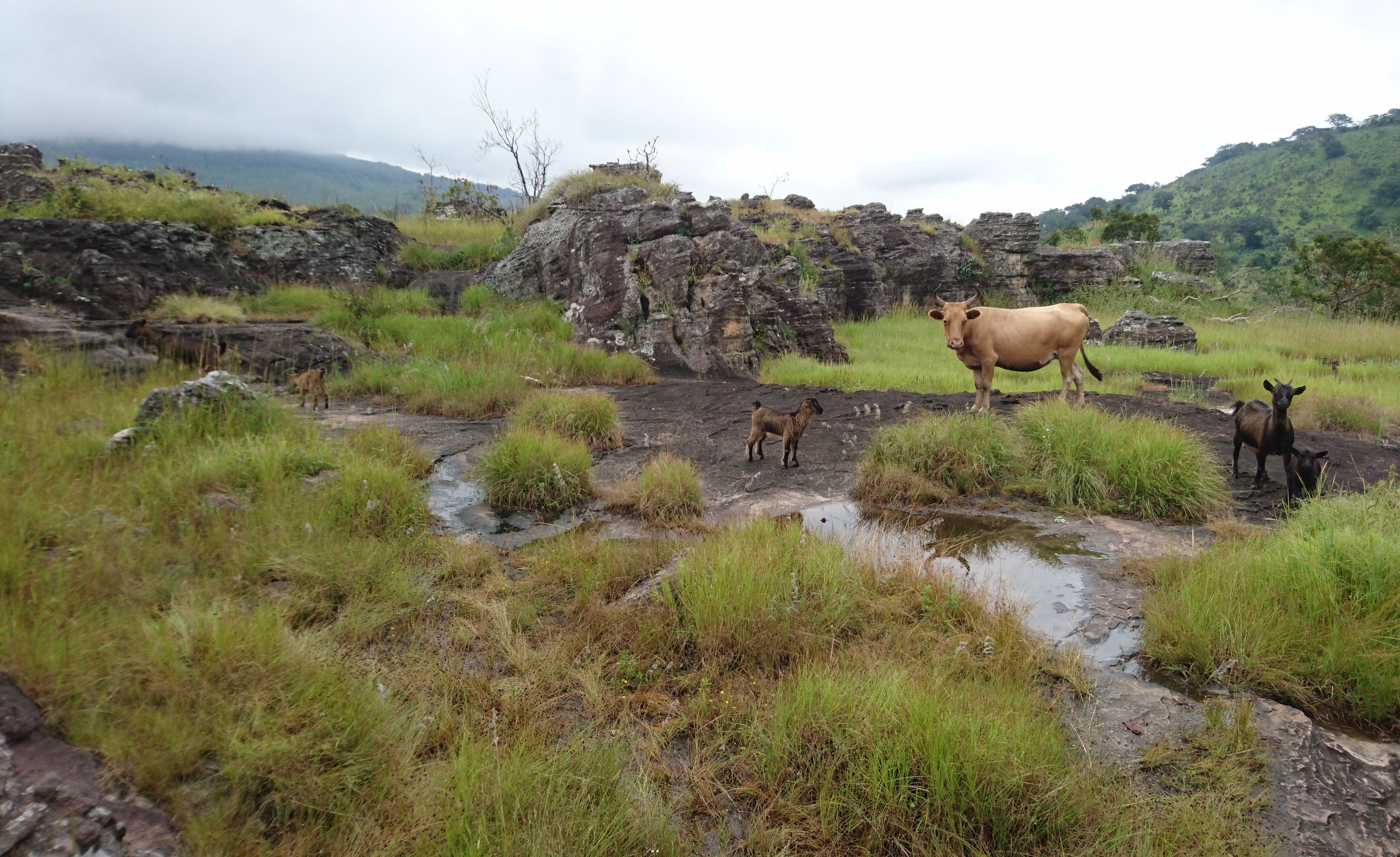
Country: Guinea
Administrative region: Dalaba (Prefecture)
Central co-ordinates: 10.63306 N, 12.27861 W
Area: 1km²
Qualifying IPA Criteria
A(i)Site contains one or more globally threatened species, A(iii)Site contains one or more highly restricted endemic species that are potentially threatened, C(iii)Site contains nationally threatened or restricted habitat or vegetation types, AND/OR habitats that have severely declined in extent nationally
IPA assessment rationale
The site at Koba represents the largest populations of Mesanthemum tuberosum and Raphionacme caerulea in the Fouta Djallon and is a good example of high altitude sandstone bowal. This is a pure sandstone outcrop and is unlike some other bowal areas in the Fouta which are iron-based bowal. Mesanthemum tuberosum is endemic to the Fouta Djallon, and although present in many areas in small numbers, there is no other site at present with such a concentration.
Site description
Sandstone outcrop and bowal, known locally as ‘kapété’, with shallow and medium depth soils, close to the village of Koba, c. 7km south west of the town of Dalaba. Grassland with trees in the deeper soils or growing through cracks in the rocky outcrop. The outcrop is part of the high altitude plateau of the Fouta Djallon and is between 1050m and 1350m altitude and c. 1km2 in area.

Botanical significance
The flat, plain area has the largest population of Mesanthemum tuberosum (rediscovered in 2017) found in the Fouta Djallon area. It also has a population of Raphionacme caerulea. This is a good example of high altitude sandstone bowal in the Moyenne Guinee region. It is considered likely that revisiting the site at different seasons (e.g. Oct), will result in additional threatened species being identified.
Habitat and geology
High altitude sandstone bowal grassland, dominated by Elymandra subulata with many herbs present including Mesanthemum tuberosum, Buchnera bowalensis, Cyanotis arachnoidea, Cyanotis lanata, Tephrosia platycarpa, Crotalaria lathyroides, Fimbristylis schweinfurthiana, Nemum spadiceum, Raphionacme caerulea and Platycornye paludosa. In the deeper soil pockets, trees and shrubs of Dichaetanthera echinulata, Vismia guineensis and Psorospermum febrifugum and Ficus sp. can be found. There is a river to the south west of the site with riverine species present.
This area is part of the Oundou series of interbedded quarzitic sandstone and dolomitic clays with Mesozoic intrusions of dolerite or gabbro-dolerites. (Source: Carte des Mineraux Utiles de la Republique de Guinee, 2006).
Conservation issues
The area is used for grazing cattle and goats and this could cause problems for some species from grazing and trampling. Also, increased nitrification of the soil may lead to enrichment and a decrease in species diversity. It has been observed that the Raphionacme caerulea plants do not seem to make it to seed dispersal stages – plants viewed in flower and GPS marked, could not be refound in the fruiting season (Couch, pers. Obs. 2017).
Site assessor(s)
Charlotte Couch, Royal Botanic Gardens Kew
Martin Cheek, Royal Botanic Gardens Kew
IPA criterion A species
| Species | Qualifying sub-criterion | ≥ 1% of global population | ≥ 5% of national population | 1 of 5 best sites nationally | Entire global population | Socio-economically important | Abundance at site |
|---|---|---|---|---|---|---|---|
| Raphionacme caerulea E.A.Bruce | A(i) |  |
 |
 |
 |
 |
Scarce |
| Mesanthemum tuberosum Lecomte | A(i) |  |
 |
 |
 |
 |
Frequent |
| Cyanotis ganganensis Schnell | A(i) |  |
 |
 |
 |
 |
Scarce |
| Dichaetanthera echinulata Hook.f. | A(i) |  |
 |
 |
 |
 |
Scarce |
Raphionacme caerulea E.A.Bruce





Mesanthemum tuberosum Lecomte





Cyanotis ganganensis Schnell





Dichaetanthera echinulata Hook.f.





IPA criterion C qualifying habitats
| Habitat | Qualifying sub-criterion | ≥ 5% of national resource | ≥ 10% of national resource | 1 of 5 best sites nationally | Areal coverage at site |
|---|---|---|---|---|---|
| High Altitude Sandstone Bowal Grasslands | C(iii) |  |
 |
 |
1 |
High Altitude Sandstone Bowal Grasslands


General site habitats
| General site habitat | Percent coverage | Importance |
|---|---|---|
| Grassland - Subtropical/Tropical Seasonally Wet/Flooded Lowland Grassland |  |
Grassland - Subtropical/Tropical Seasonally Wet/Flooded Lowland Grassland

Land use types
| Land use type | Percent coverage | Importance |
|---|---|---|
| Agriculture (pastoral) |  |
Minor |
Agriculture (pastoral)

Threats
| Threat | Severity | Timing |
|---|---|---|
| Agriculture & aquaculture - Livestock farming & ranching - Small-holder grazing, ranching or farming | Medium | Ongoing - stable |
| Natural system modifications - Fire & fire suppression - Increase in fire frequency/intensity | Medium | Ongoing - stable |
Agriculture & aquaculture - Livestock farming & ranching - Small-holder grazing, ranching or farming
Natural system modifications - Fire & fire suppression - Increase in fire frequency/intensity
Bibliography
Flore (Angiospermes) de la République de Guinée.
Threatened plants species of Guinea-Conakry: A preliminary checklist
Peerj Preprints
IUCN Red List
Mesanthemum tuberosum Lecomte resurrected from M. prescottianum (Bong.) Körn. (Eriocaulaceae), variation and lectotypification
Kew Bulletin, Vol 73:13 (pub. Springer London) Available online
TIPAs Guinea Darwin Project report: Field expedition to Fouta Djalon
TIPAs Guinea Darwin Project report: Field expedition to Fouta Djallon
Recommended citation
Charlotte Couch, Martin Cheek (2024) Tropical Important Plant Areas Explorer: Koba sandstone bowal (Guinea). https://tipas.kew.org/site/koba-sandstone-bowal/ (Accessed on 27/07/2024)


